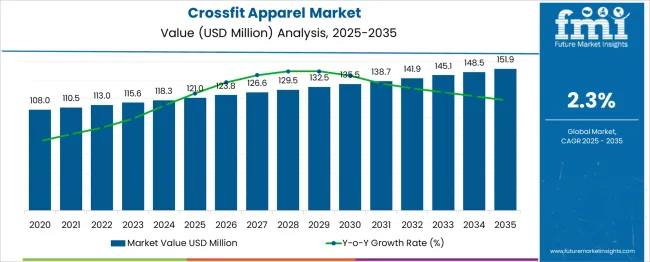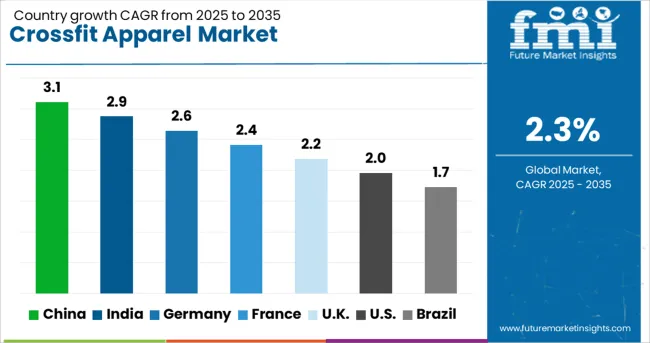The Crossfit Apparel Market is estimated to be valued at USD 121.0 million in 2025 and is projected to reach USD 151.9 million by 2035, registering a compound annual growth rate (CAGR) of 2.3% over the forecast period.

| Metric | Value |
|---|---|
| Crossfit Apparel Market Estimated Value in (2025 E) | USD 121.0 million |
| Crossfit Apparel Market Forecast Value in (2035 F) | USD 151.9 million |
| Forecast CAGR (2025 to 2035) | 2.3% |
The increasing number of sports tournaments is significantly driving the crossfit apparel market growth, though factors such as volatile raw material prices may impede the market.
The rise in sales of crossfit apparel is also due to the growing interest in sports activities among the world's population.
For example, as the number of registered baseball players has increased, so has the number of baseball and softball tournaments and matches.
The American Athletic Conference Baseball Tournament, for example, was established in 2014 as a college-level baseball conference championship tournament.
Such tournaments are expected to help popularise baseball around the world while also benefiting the global baseball equipment market. During the forecast period, this is considered to augur well for the global crossfit apparel market's future trends.
Fashionable sports apparel is in high demand as it is versatile, convenient, trendy, and can be worn for a variety of occasions.
The crossfit apparel market share is enlarged by the market players as they are successful in capitalizing on the increased emphasis on style.
These market players have introduced innovative, technologically advanced products that are both comfortable and practical to meet this demand, opening up a wide array of crossfit apparel market opportunities.
Another factor fostering the crossfit apparel market growth is the demand for fashionable color combinations in various sports activities.
The profit margins of the major crossfit clothing brands, such as Nike, PUMA, and Adidas, are unstable, and the same is due to fluctuating raw material prices and increasing market competition among crossfit clothing companies.
Price wars among top crossfit clothing brands result from the emergence of local players, and the same forces vendors to lower the prices of their products, which reduces their profit margins as well as crossfit apparel market share.
As a result, rising raw material prices have a negative impact on vendors' profit margins, limiting the crossfit apparel market growth.
The crossfit market statistics are likely to witness a positive phase due to the increase in adventure sports, growing geriatric population, and rising obese population as people shift their focus to healthy living for the aforementioned reasons.
However, several factors, such as labor shortages and unprecedented growth in e-commerce changing consumer preferences, are likely to have a negative impact on the crossfit apparel market growth.
On the basis of product, the crossfit apparel market is segmented into shirts, pants, and others, including shorts, sweatshirts & hoodies, and tank-top.
The top wear segment is estimated to be at the forefront of the crossfit apparel market during the forecast period.
The USA is the largest regional market for the top wear segment, accounting for a major crossfit apparel market share.
By material type, the market is categorized into nylon, wool, polyester, and others.
The crossfit apparel market, based on consumer orientation, is segmented into men, women, and unisex.
During the forecast period, the women's crossfit apparel market share is expected to grow significantly.
Some of the factors driving this segment are an increase in the demand from developing countries, the number of working women, and the recovery from the recession.
Another factor contributing to the segment's growth is the significant increase in women's participation in sports and fitness activities in various countries around the globe.
This has narrowed the gender participation gap and augmented per-unit sales of crossfit apparel, propelling the overall market growth.
Women are more fashion-conscious than men, requiring top crossfit clothing companies to update their product line with new designs and styles in order to encourage more female consumers.
On account of all of these factors, the segment is expected to grow rapidly during the forecast period, majorly contributing to the overall crossfit apparel market size.
Based on sales channels, the market is divided into direct Sales, franchised Stores, specialty stores, online retailers, and other sales channels such as mono-brand stores, and wholesalers/retailers.

The USA is anticipated to hold a major crossfit apparel market share on account of the highly evolved retail structure and increased adoption of sports apparel as a result of aggressive advertising and celebrity brand endorsement.
Increased consumer spending on fitness apparel as a fashion statement contributes to the crossfit apparel market size in this region.
Due to rapidly improving retail infrastructure and rising disposable income in China, the region is expected to witness a huge demand for crossfit apparel.
China is also aided by government initiatives to encourage active participation in sports, leading to rising sales of crossfit apparel in the region.
The crossfit apparel market in India is fostered by the growing appetite for foreign brands, a desire to live a healthier lifestyle, and rising disposable income in the region.
The crossfit apparel market is fragmented, with only a few notable international and regional players.
The crossfit apparel brands are competing by deploying growth strategies such as quality, price, brand, and variety, in turn, shaping the crossfit apparel market's key trends & opportunities.
The players in the crossfit apparel market have adopted acquisition as their primary development strategy in order to increase profitability and augment their crossfit apparel market share.
Product launches have also been used by key players to improve their product portfolios, stay relevant, and consolidate their position in the global market.
Some of the recent developments in crossfit apparel market are as follows:
The global crossfit apparel market is estimated to be valued at USD 121.0 million in 2025.
The market size for the crossfit apparel market is projected to reach USD 151.9 million by 2035.
The crossfit apparel market is expected to grow at a 2.3% CAGR between 2025 and 2035.
The key product types in crossfit apparel market are shirts, pants and others.
In terms of material type, nylon segment to command 36.5% share in the crossfit apparel market in 2025.






Our Research Products

The "Full Research Suite" delivers actionable market intel, deep dives on markets or technologies, so clients act faster, cut risk, and unlock growth.

The Leaderboard benchmarks and ranks top vendors, classifying them as Established Leaders, Leading Challengers, or Disruptors & Challengers.

Locates where complements amplify value and substitutes erode it, forecasting net impact by horizon

We deliver granular, decision-grade intel: market sizing, 5-year forecasts, pricing, adoption, usage, revenue, and operational KPIs—plus competitor tracking, regulation, and value chains—across 60 countries broadly.

Spot the shifts before they hit your P&L. We track inflection points, adoption curves, pricing moves, and ecosystem plays to show where demand is heading, why it is changing, and what to do next across high-growth markets and disruptive tech

Real-time reads of user behavior. We track shifting priorities, perceptions of today’s and next-gen services, and provider experience, then pace how fast tech moves from trial to adoption, blending buyer, consumer, and channel inputs with social signals (#WhySwitch, #UX).

Partner with our analyst team to build a custom report designed around your business priorities. From analysing market trends to assessing competitors or crafting bespoke datasets, we tailor insights to your needs.
Supplier Intelligence
Discovery & Profiling
Capacity & Footprint
Performance & Risk
Compliance & Governance
Commercial Readiness
Who Supplies Whom
Scorecards & Shortlists
Playbooks & Docs
Category Intelligence
Definition & Scope
Demand & Use Cases
Cost Drivers
Market Structure
Supply Chain Map
Trade & Policy
Operating Norms
Deliverables
Buyer Intelligence
Account Basics
Spend & Scope
Procurement Model
Vendor Requirements
Terms & Policies
Entry Strategy
Pain Points & Triggers
Outputs
Pricing Analysis
Benchmarks
Trends
Should-Cost
Indexation
Landed Cost
Commercial Terms
Deliverables
Brand Analysis
Positioning & Value Prop
Share & Presence
Customer Evidence
Go-to-Market
Digital & Reputation
Compliance & Trust
KPIs & Gaps
Outputs
Full Research Suite comprises of:
Market outlook & trends analysis
Interviews & case studies
Strategic recommendations
Vendor profiles & capabilities analysis
5-year forecasts
8 regions and 60+ country-level data splits
Market segment data splits
12 months of continuous data updates
DELIVERED AS:
PDF EXCEL ONLINE
Apparel Market Size and Share Forecast Outlook 2025 to 2035
Apparel Re-commerce Market Size and Share Forecast Outlook 2025 to 2035
Gym Apparel Market Size and Share Forecast Outlook 2025 to 2035
Pet Apparel Market Analysis - Size, Demand & Forecast 2025 to 2035
Chef Apparel Market Size and Share Forecast Outlook 2025 to 2035
Kids Apparel Market Trends - Growth, Demand & Forecast 2025 to 2035
Rugby Apparel Market Forecast and Outlook 2025 to 2035
Blank Apparel Market – Growth & Demand Forecast 2025 to 2035
Bamboo Apparel Market Size and Share Forecast Outlook 2025 to 2035
Outdoor Apparel and Accessories Market Size and Share Forecast Outlook 2025 to 2035
Sequins Apparel Market Size and Share Forecast Outlook 2025 to 2035
TIC For Apparel Market
Maternity Apparel Market Size and Share Forecast Outlook 2025 to 2035
Decorated Apparel Market segmented by Product, End-user and Distribution Channel through 2025 to 2035
Market Share Distribution Among Maternity Apparel Providers
Equestrian Apparel Market Size and Share Forecast Outlook 2025 to 2035
Secondhand Apparel Market Analysis - Size, Share, and Forecast 2025 to 2035
Competitive Overview of Secondhand Apparel Market Share
Second-hand Apparel Market in Europe Analysis - Size, Share, and Forecast Outlook 2025 to 2035
The Dye Sublimated Apparel Market is segmented by product, printing technique, distribution and region through 2025 to 2035.

Thank you!
You will receive an email from our Business Development Manager. Please be sure to check your SPAM/JUNK folder too.
Chat With
MaRIA